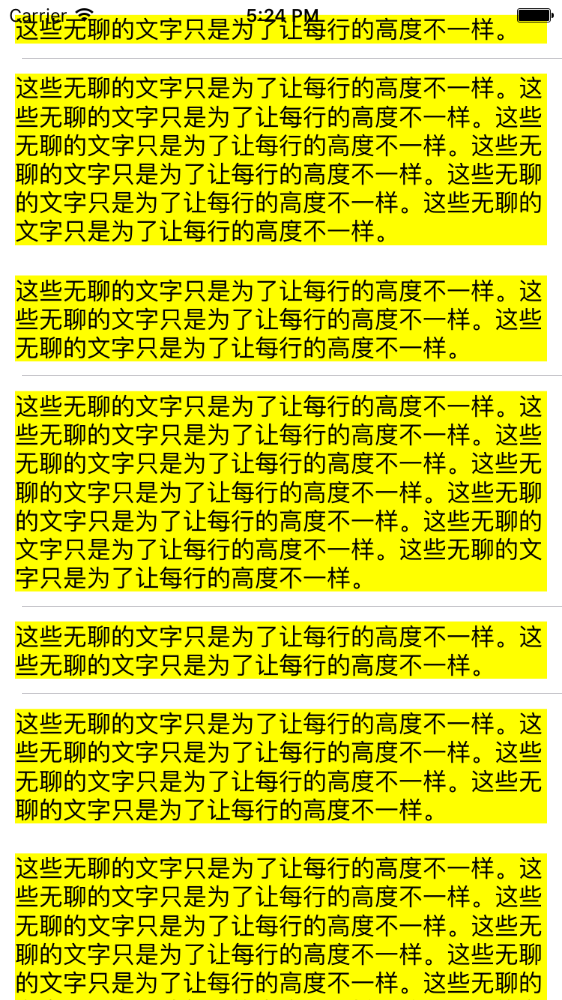在日常的开发中我们经常遇到UITableView的cell根据里边的内容动态计算其高度,其中动态计算其高度的方法有很多,在这里我将先介绍其中的一种方法,这种方法的应用比较简单方便,而且可以更快的实现cell的高度自适应
创建UITableView
1 在创建UITableView之前我通过懒加载的方式创建了一个数据源数组dataSourceArr,其中保存的是一些不同长度的字符串用来添加到cell中实现cell的不同的高度
2 添加UITableView,遵守数据源
- (void)viewDidLoad {
[super viewDidLoad];
UITableView *mainTableView = [[UITableView alloc]initWithFrame:self.view.bounds];
self.mainTableView = mainTableView;
[self.view addSubview:mainTableView];
self.mainTableView.dataSource = self;
}3 实现必须实现的两个数据源方法
// 返回每个区域中有几行cell
- (NSInteger)tableView:(UITableView *)tableView numberOfRowsInSection:(NSInteger)section{
return self.dataSourceArr.count;
}
// 返回每个cell的样式
- (UITableViewCell *)tableView:(UITableView *)tableView cellForRowAtIndexPath:(NSIndexPath *)indexPath{
static NSString *ID = @"MainTableViewCell";
MainTableViewCell *cell = [tableView dequeueReusableCellWithIdentifier:ID];
if (cell == nil) {
cell = [[MainTableViewCell alloc]initWithStyle:UITableViewCellStyleDefault reuseIdentifier:ID];
}
NSString *testStr = self.dataSourceArr[indexPath.row];
// 以下的两个赋值方法千万不能把顺序写反了,因为我们是根据其展示的内容计算的高度
cell.testStr = testStr;
tableView.rowHeight = cell.rowHeight;
cell.selectionStyle = UITableViewCellSelectionStyleNone;
return cell;
}其中testStr为该行中UILabel中将要展示的字符串,cell为下边自定义的cell。在这里我们将自定义cell中根据不同内容计算出来的每个cell的高度保存在cell的rowHeight属性中,并且通过tableView.rowHeight为每个cell的高度赋值,这样就可以在返回cell的数据源方法中为每个cell赋值不同的所需高度
自定义UITableViewCell并且根据内容计算高度
1 创建MainTableViewCell类,继承自UITableViewCell,自定义出cell的样式,在此案例中为了展示出不同的高度我只在其中添加了一个UILabel。开发中可以根据自己的需求创建不同的控件,计算高度的原理是相同的。
- (instancetype)initWithStyle:(UITableViewCellStyle)style reuseIdentifier:(NSString *)reuseIdentifier{
if (self = [super initWithStyle:style reuseIdentifier:reuseIdentifier]) {
[self configureCell];
}
return self;
}
// 创建自定义cell的内容控件
- (void)configureCell{
UILabel *testLabel = [[UILabel alloc]init];
self.testLabel = testLabel;
[self addSubview:testLabel];
testLabel.backgroundColor = [UIColor yellowColor];
testLabel.font = [UIFont systemFontOfSize:16];
testLabel.numberOfLines = 0;
}2 在此类的.h文件中声明两个属性,一个为了传递UILabel中展示的字符串,一个为了保存计算出的每个cell的高度
@interface MainTableViewCell : UITableViewCell
// 保存每个cell的UILabel中展示的字符串
@property(copy,nonatomic)NSString *testStr;
// 保存计算出来的每个cell的高度
@property(assign,nonatomic)CGFloat rowHeight;
@end3 通过重写赋值字符串的setter方法为每个UILable赋值,并计算出UILabel所需要的高度
- (void)setTestStr:(NSString *)testStr{
_testStr = testStr;
self.testLabel.text = testStr;
// 调用计算控件布局和cell高度的方法
[self setupSubViewConstrainWithStr:testStr];
}- (void)setupSubViewConstrainWithStr:(NSString *)testStr{
CGFloat width = [UIScreen mainScreen].bounds.size.width;
// 根据Label的内容计算所需要的高度,maxSize为控件的最大的宽高
CGSize maxSize = CGSizeMake(width-20, CGFLOAT_MAX);
CGRect rect = [testStr boundingRectWithSize:maxSize options:NSStringDrawingUsesLineFragmentOrigin attributes:@{NSFontAttributeName:[UIFont systemFontOfSize:16]} context:nil];
self.testLabel.frame = CGRectMake(10, 10, width-20, rect.size.height);
// 如果此处有多个控件可以获取最后一个控件的最大Y值,也可以将里边的全部控件的高度加起来,之后保存到自己的rowHeight属性中
// 此方法的核心就是在这里通过cell里边的控件计算出这个cell应有的高度,保存起来,然后在数据源方法中利用tableView.rowHeight方法为其赋值
self.rowHeight = CGRectGetMaxY(self.testLabel.frame)+10;
}最后实现不同内容cell展现了不同的高度,效果如下:
总结
动态计算cell高度的方法还有其他的,比如frameModel的方法,利用UITableView的代理返回cell高度的方法,但是我认为这种方法在开发中用起来比较简单方便,所以在这里做一下简单的介绍,其中的核心就是UITableView的rowHeight属性。






















 97
97











 被折叠的 条评论
为什么被折叠?
被折叠的 条评论
为什么被折叠?








